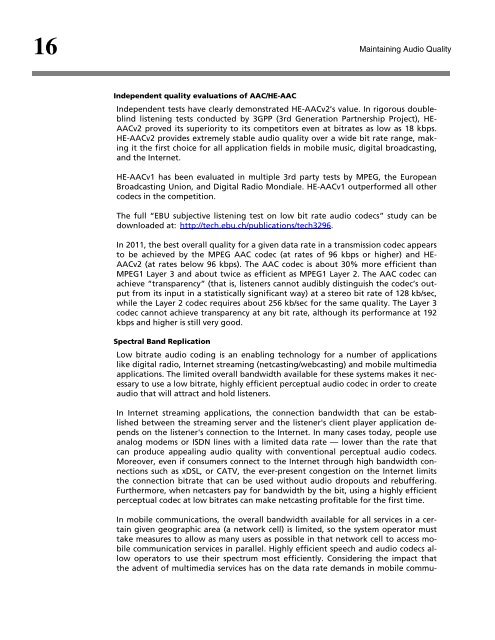Maintaining Audio Quality in the Broadcast Facility 2011 - Orban
Maintaining Audio Quality in the Broadcast Facility 2011 - Orban
Maintaining Audio Quality in the Broadcast Facility 2011 - Orban
You also want an ePaper? Increase the reach of your titles
YUMPU automatically turns print PDFs into web optimized ePapers that Google loves.
16<br />
Independent quality evaluations of AAC/HE-AAC<br />
<strong>Ma<strong>in</strong>ta<strong>in</strong><strong>in</strong>g</strong> <strong>Audio</strong> <strong>Quality</strong><br />
Independent tests have clearly demonstrated HE-AACv2’s value. In rigorous doublebl<strong>in</strong>d<br />
listen<strong>in</strong>g tests conducted by 3GPP (3rd Generation Partnership Project), HE-<br />
AACv2 proved its superiority to its competitors even at bitrates as low as 18 kbps.<br />
HE-AACv2 provides extremely stable audio quality over a wide bit rate range, mak<strong>in</strong>g<br />
it <strong>the</strong> first choice for all application fields <strong>in</strong> mobile music, digital broadcast<strong>in</strong>g,<br />
and <strong>the</strong> Internet.<br />
HE-AACv1 has been evaluated <strong>in</strong> multiple 3rd party tests by MPEG, <strong>the</strong> European<br />
<strong>Broadcast</strong><strong>in</strong>g Union, and Digital Radio Mondiale. HE-AACv1 outperformed all o<strong>the</strong>r<br />
codecs <strong>in</strong> <strong>the</strong> competition.<br />
The full “EBU subjective listen<strong>in</strong>g test on low bit rate audio codecs” study can be<br />
downloaded at: http://tech.ebu.ch/publications/tech3296.<br />
In <strong>2011</strong>, <strong>the</strong> best overall quality for a given data rate <strong>in</strong> a transmission codec appears<br />
to be achieved by <strong>the</strong> MPEG AAC codec (at rates of 96 kbps or higher) and HE-<br />
AACv2 (at rates below 96 kbps). The AAC codec is about 30% more efficient than<br />
MPEG1 Layer 3 and about twice as efficient as MPEG1 Layer 2. The AAC codec can<br />
achieve “transparency” (that is, listeners cannot audibly dist<strong>in</strong>guish <strong>the</strong> codec’s output<br />
from its <strong>in</strong>put <strong>in</strong> a statistically significant way) at a stereo bit rate of 128 kb/sec,<br />
while <strong>the</strong> Layer 2 codec requires about 256 kb/sec for <strong>the</strong> same quality. The Layer 3<br />
codec cannot achieve transparency at any bit rate, although its performance at 192<br />
kbps and higher is still very good.<br />
Spectral Band Replication<br />
Low bitrate audio cod<strong>in</strong>g is an enabl<strong>in</strong>g technology for a number of applications<br />
like digital radio, Internet stream<strong>in</strong>g (netcast<strong>in</strong>g/webcast<strong>in</strong>g) and mobile multimedia<br />
applications. The limited overall bandwidth available for <strong>the</strong>se systems makes it necessary<br />
to use a low bitrate, highly efficient perceptual audio codec <strong>in</strong> order to create<br />
audio that will attract and hold listeners.<br />
In Internet stream<strong>in</strong>g applications, <strong>the</strong> connection bandwidth that can be established<br />
between <strong>the</strong> stream<strong>in</strong>g server and <strong>the</strong> listener's client player application depends<br />
on <strong>the</strong> listener's connection to <strong>the</strong> Internet. In many cases today, people use<br />
analog modems or ISDN l<strong>in</strong>es with a limited data rate — lower than <strong>the</strong> rate that<br />
can produce appeal<strong>in</strong>g audio quality with conventional perceptual audio codecs.<br />
Moreover, even if consumers connect to <strong>the</strong> Internet through high bandwidth connections<br />
such as xDSL, or CATV, <strong>the</strong> ever-present congestion on <strong>the</strong> Internet limits<br />
<strong>the</strong> connection bitrate that can be used without audio dropouts and rebuffer<strong>in</strong>g.<br />
Fur<strong>the</strong>rmore, when netcasters pay for bandwidth by <strong>the</strong> bit, us<strong>in</strong>g a highly efficient<br />
perceptual codec at low bitrates can make netcast<strong>in</strong>g profitable for <strong>the</strong> first time.<br />
In mobile communications, <strong>the</strong> overall bandwidth available for all services <strong>in</strong> a certa<strong>in</strong><br />
given geographic area (a network cell) is limited, so <strong>the</strong> system operator must<br />
take measures to allow as many users as possible <strong>in</strong> that network cell to access mobile<br />
communication services <strong>in</strong> parallel. Highly efficient speech and audio codecs allow<br />
operators to use <strong>the</strong>ir spectrum most efficiently. Consider<strong>in</strong>g <strong>the</strong> impact that<br />
<strong>the</strong> advent of multimedia services has on <strong>the</strong> data rate demands <strong>in</strong> mobile commu-



![[PDF] Using the ITU BS.1770-2 and CBS Loudness Meters ... - Orban](https://img.yumpu.com/50629372/1/190x245/pdf-using-the-itu-bs1770-2-and-cbs-loudness-meters-orban.jpg?quality=85)






![[PDF] Optimod-FM Feature Comparison - Orban](https://img.yumpu.com/41741615/1/190x245/pdf-optimod-fm-feature-comparison-orban.jpg?quality=85)






